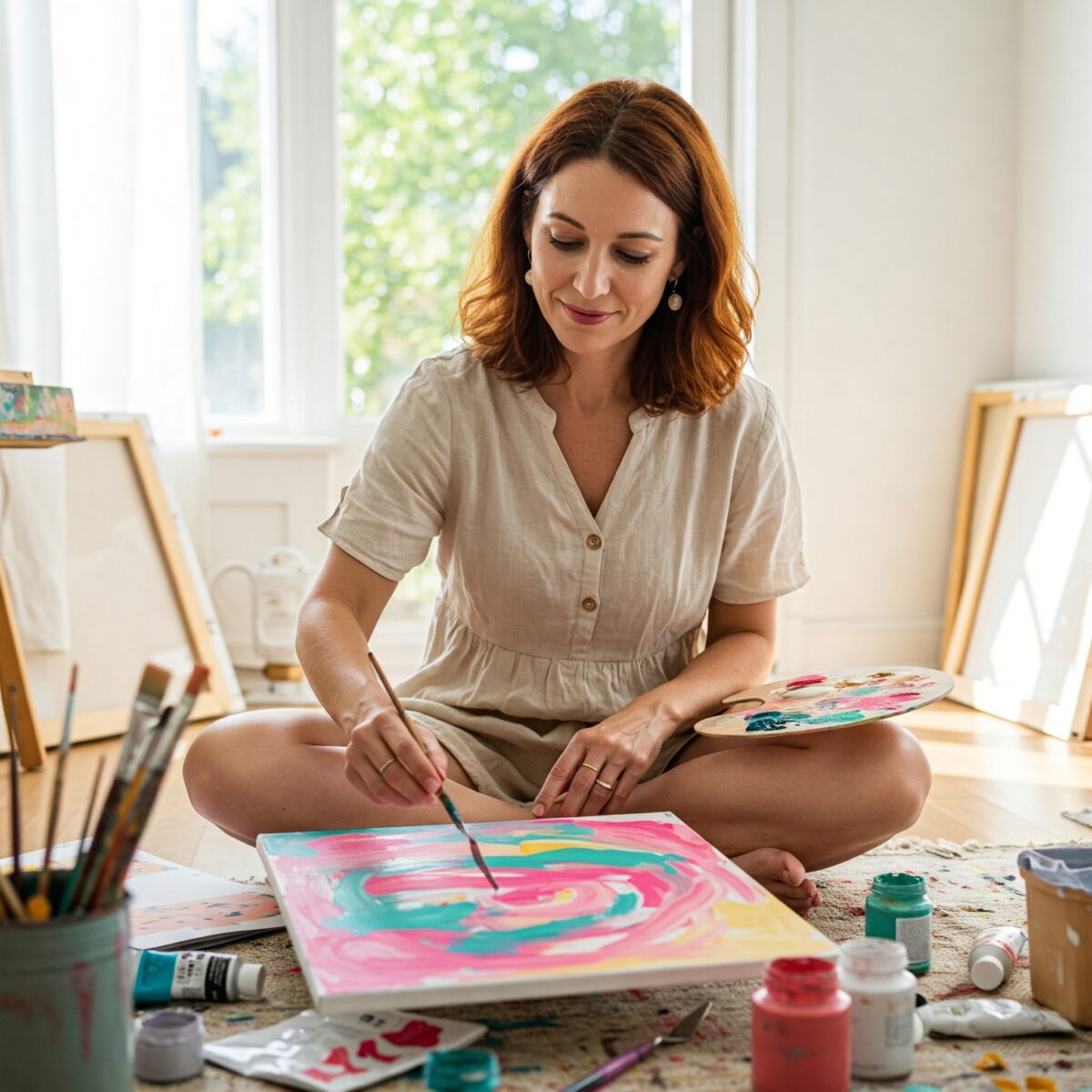Art therapy activities have become increasingly popular for those seeking natural ways to manage stress and anxiety in the comfort of their own homes. Unlike regular art-making, art therapy uses creative expression as a tool for emotional healing and self-discovery. You don’t need to be an artist to benefit from these techniques – just a willingness to explore your feelings through colors, shapes, and textures. When you engage in art therapy activities, you’re giving your mind a break from worry while processing emotions in a healthy, constructive way.
Key Points:
- Art therapy uses creative expression to reduce stress and process emotions
- No artistic experience is needed to benefit from art therapy activities
- Simple supplies you likely already have at home are all you need
- Regular practice can improve mental wellbeing and emotional resilience
- Different techniques target different emotional needs and stress responses
What Are Art Therapy Activities?
Art therapy activities are creative exercises designed to help people express their feelings, reduce stress, and gain insights about themselves. Unlike making art just for fun, art therapy has the specific goal of improving your mental and emotional wellbeing. When you’re feeling overwhelmed, anxious, or just need to unwind, these activities can provide a healthy outlet for those emotions.
According to the American Art Therapy Association, art therapy is a mental health profession where the process of making art is used to improve physical, mental, and emotional wellness. While professional art therapists have specialized training, many art therapy techniques can be adapted for home use when you need stress relief.
“Art washes away from the soul the dust of everyday life.”
Pablo Picasso
Simple Art Therapy Supplies You Need
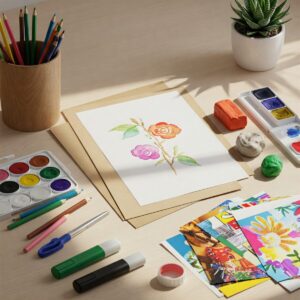
Getting started with art therapy at home doesn’t require expensive materials. Most of these supplies are things you might already have around the house:
- Drawing paper or sketchbook
- Colored pencils or markers
- Watercolors
- Clay or modeling material
- Old magazines for collage
- Scissors and glue
- Soft pastels
- Plain canvas or canvas paper
Remember, the focus isn’t on creating perfect art – it’s about the process and emotional expression. Don’t worry about buying professional-grade supplies when you’re just starting out.

5 Effective Art Therapy Activities for Stress Relief
Here are five simple art therapy activities you can try at home when you’re feeling stressed:
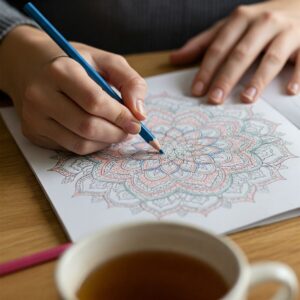
1. Mindful Coloring
Adult coloring books have surged in popularity, and for good reason. Mindful coloring involves focusing entirely on the present moment as you fill in patterns with color. This practice can help quiet anxious thoughts and provide a sense of calm.
How to do it:
- Choose a coloring page with patterns like mandalas or nature scenes
- Select colors that appeal to you in the moment
- Focus on the sensation of coloring – the pressure of the pencil, the emerging colors
- When your mind wanders, gently bring attention back to coloring
- Take slow, deep breaths as you work
For more detailed patterns, check out our article on how to discover meaning in abstract art, which explores how patterns and symbols can affect our emotions.
2. Expressive Painting
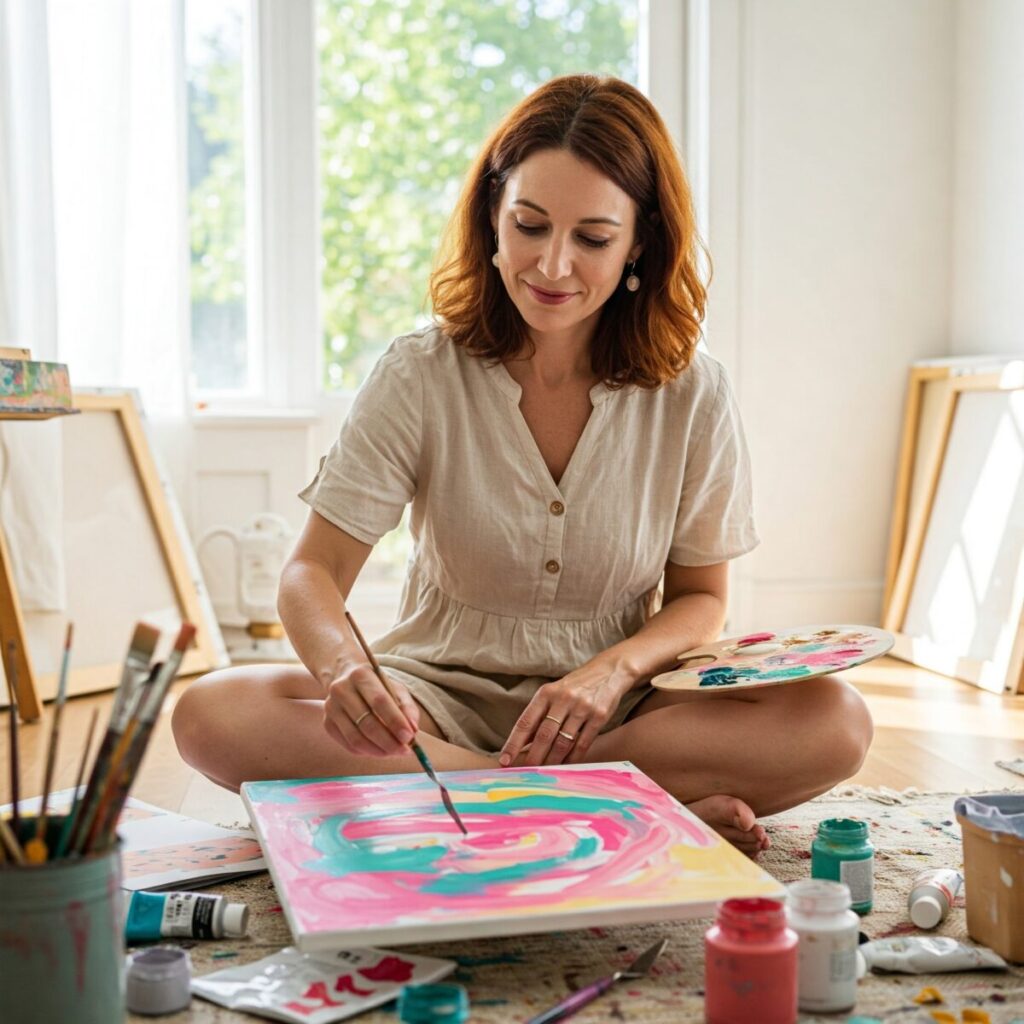
Expressive painting lets you translate your feelings directly into color and form without worrying about making something that “looks good.”
How to do it:
- Set up your painting space with paper or canvas and paints
- Take a few deep breaths and think about how you’re feeling
- Choose colors that match your emotions
- Apply paint freely without planning – let your hand move as it wishes
- Focus on the process, not the final product
- When finished, reflect on what your painting reveals about your current emotional state
Learn more about using colors for emotional expression in our guide to how to create mood with color choices.
3. Visual Journaling

Visual journaling combines art-making with written reflection to process emotions and experiences. This practice can help you identify patterns in your thoughts and feelings over time.
How to do it:
- Get a blank journal or sketchbook
- Divide each page into sections for art and writing
- Use any materials you like – markers, collage, watercolors
- Create an image representing your current feelings
- Write about what emerged in your artwork
- Date each entry to track your emotional journey
This technique works well alongside traditional journaling. Our article on painting emotions provides additional insights on how to translate feelings into visual form.
4. Clay Sculpting
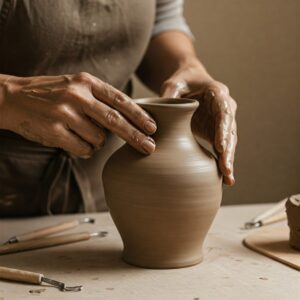
Clay work is especially effective for stress relief because it engages your sense of touch and provides physical resistance as you work, which can help release tension.
How to do it:
- Take a piece of clay or modeling material
- Close your eyes and focus on the texture
- Knead and shape the clay without trying to make anything specific
- Notice how the clay responds to pressure and movement
- If you’re feeling angry or frustrated, try squeezing or pounding the clay
- Eventually, let a form emerge that represents how you feel
Clay work connects to the concept of grounding, which you can explore further in our article on creating focal points in artwork.
5. Emotion Color Wheel
Creating an emotion color wheel helps you visualize connections between colors and feelings, giving you a tool for emotional awareness.
How to do it:
- Draw a circle and divide it into 6-8 sections
- Identify different emotions you’ve experienced recently
- Choose a color that represents each emotion
- Fill in each section with its corresponding color
- Add patterns, symbols, or words that connect to each emotion
- Use your finished wheel as a reference for identifying feelings
This activity relates to color theory, which you can learn more about in our guide to color theory basics.
Art Therapy vs. Regular Art-Making
Many people wonder how art therapy differs from simply making art as a hobby. Here’s a comparison:
| Art Therapy | Regular Art-Making |
|---|---|
| Focus on emotional process | Focus on finished product |
| Intention to explore feelings | Intention to create something visually appealing |
| No technical skill required | May involve learning techniques |
| Reflection on personal meaning | External evaluation or display |
| Therapeutic goal | Entertainment or skill-building goal |
Both approaches have value, but art therapy specifically targets emotional wellbeing. You might enjoy both for different reasons!
Establishing an Art Therapy Routine
For maximum benefit, try to establish a regular art therapy practice:
- Create a dedicated space where you can make art without interruption
- Schedule consistent time for your practice, even just 15-20 minutes
- Eliminate distractions by turning off devices and finding quiet
- Start with an intention but remain open to what emerges
- End with reflection on what you created and how you feel
As noted by art therapy expert Dr. Cathy Malchiodi, “Regular creative expression can create pathways in the brain that help regulate emotions over time.”
Recommended Art Therapy Resources
To deepen your art therapy practice, consider these external resources:
- Psychology Today – Art Therapy Exercises
- American Art Therapy Association Resources
- Harvard Health Publishing on Creative Arts Therapies
YouTube offers many excellent tutorials as well. This video demonstrates some simple art therapy techniques you can try at home:
When to Seek Professional Help
While home art therapy activities can provide significant stress relief, they aren’t a replacement for professional mental health treatment. Consider working with a registered art therapist or mental health professional if:
- Your stress or anxiety feels overwhelming
- You’re experiencing depression or trauma symptoms
- You want guidance on interpreting your artwork
- Self-directed activities don’t seem to be helping
Art therapy activities can complement other mental health treatments and self-care practices. For more on how creativity supports mental health, read our article on art for well-being and mental health.
Art Therapy Activities for Different Emotional Needs
Different art therapy techniques work better for different emotional states:
- For anxiety: Structured activities like coloring mandalas or working with patterns
- For anger: Clay work, tearing and reassembling collage, or bold expressive painting
- For grief: Memory boxes, collage, or gentle watercolor work
- For confusion: Mind mapping with images and words, or creating visual journals
- For exhaustion: Simple sensory activities with minimal steps and low pressure
Explore what works best for your unique emotional needs. Our article on painting techniques for beginners can help you expand your technical toolkit.
Getting Started Today
The beauty of art therapy activities is their accessibility – you can start right now with whatever supplies you have on hand. Begin with just 10 minutes of creative time focused on emotional expression rather than artistic outcome.
Remember that there’s no wrong way to do art therapy at home. Your experience will be unique to you, and the benefits come from the process itself rather than what you create. By integrating art therapy activities into your regular self-care routine, you’ll develop valuable tools for managing stress and processing emotions in healthy ways.
Find Your Perfect Art Therapy Activity
How are you feeling today? Select your current emotional state to discover an art therapy activity that might help.
FAQs About Art Therapy Activities
How effective is art therapy for anxiety?
Research has shown art therapy can be highly effective for reducing anxiety symptoms by activating the relaxation response, providing healthy distraction, and helping process difficult emotions through non-verbal means.
What supplies do I need for art therapy at home?
Basic supplies include drawing paper, colored pencils or markers, watercolors, clay, old magazines for collage, scissors, and glue. Start with what you have and add items as needed.
Can art therapy help with depression?
Yes, art therapy has shown benefits for depression by providing emotional expression, increasing self-awareness, and activating reward centers in the brain through creative engagement.
What’s the difference between art therapy and regular art making?
Art therapy focuses primarily on emotional processing and psychological wellbeing, while regular art making typically emphasizes skill development and creating aesthetically pleasing work. Art therapy values the process over the product.
Are art therapy activities good for beginners with no artistic experience?
Absolutely! Art therapy is ideal for beginners because it requires no artistic skill or training. The focus is on emotional expression rather than creating “good” art.

